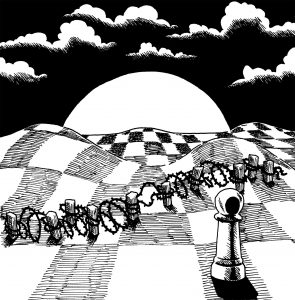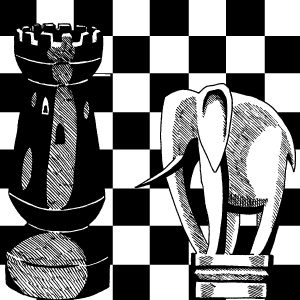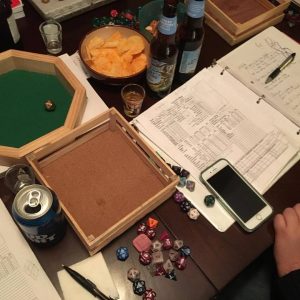The clash of steel, the pulse of blood through arteries and onto the ground and snatching glory on the  battlefield, the personal devastation realized when surveying the field of victory, roleplaying War. War can enhance a roleplaying game not just because of its opportunities for fantasy violence and power fantasies but because of its depth of emotion and intellectual involvement as well as the physical trials that characters must suffer. However, in the theater of the mind that is a roleplaying game, war becomes a mental landscape and its phases and components feature in that plane.
battlefield, the personal devastation realized when surveying the field of victory, roleplaying War. War can enhance a roleplaying game not just because of its opportunities for fantasy violence and power fantasies but because of its depth of emotion and intellectual involvement as well as the physical trials that characters must suffer. However, in the theater of the mind that is a roleplaying game, war becomes a mental landscape and its phases and components feature in that plane.
The metaphoric landscapes of war and war itself are best illustrated as actual and mental landscape, its phases as emotional fields overlapping, and the GM as landscaper of these fields when used in the context of fantasy roleplaying games. War serves as a challenge to Player Characters (PCs) as soldiers, champions, and/or even generals. Roleplaying angles include the question of the “right” side of the conflict, is there one? Moreover, the consequences of the PCs asking, or are forced to ask, those questions. The GM can also use war not only as a roleplaying opportunity or a reason for widespread violence but also as an impediment to PCs even on the level of a single battle.
In the context of RPG games, it is most useful to break War and battle into stages or phases of action. The phases of war, thus its geographical features, are the Face-Off, the Battle proper, the Aftermath, and the Consequences. These landscapes are rich and run deep with long-lasting effects, which can reach through ages via legends and songs demonstrated by the ruin left behind. The landscapes of war as played out on the stage in the theater of the mind can have great potential in roleplaying games as well as a useful device for Game-Masters.
War is an activity steeped in drama, strategy, tactics, and mortal risk often fraught with very high costs. RPG war and combat should retain some semblance of simulation to heighten personal drama and deepen immersion. That realistic or at least believable base will be able to support the addition of the fantastical elements on top. For full impact, some of the realistic effects of war should be retained as well as the competency of enemy generals. The psychological aspects should not be ignored either particularly when it can change the outcome of a battle between unequal forces in favor of the inferior.
When referring to war I am not just referring to a session of Mass Combat but a complete and widespread conflict between at least two powers over an extended length of time though battles themselves can move through identical landscape but on a much smaller scale. The consequences of smaller conflicts are more localized and the span of time would be much shorter probably counted in days maybe months. A War in this case will refer to a series of confrontations (military, personal, diplomatic, political, disruptions, insurgencies, espionage, etc.) all related to a common cause directed by the ultimate goals of the participants. Note that the results will never match exactly the desires of the powers involved.
War as Landscape
War as a landscape serves essentially the same purpose in RPGs as the actual imaginary landscapes traversed by the Player Characters (PCs). It can impede the progress of the PCs, it can serve as a journey in and of itself, and the goals met by the end of a war can serve as the ultimate goal for the entire tabletop campaign. As an Impediment to be overcome or circumvented, war can serve as the device that the Players need to avoid or prevent by achieving certain tasks. The battles and confrontations that compose the body of war can serve as their own smaller impediments. In this case, the GM can use war and battlefields as terrain and impediments to PC party progress and as barriers to be overcome through skill, diplomacy, or shear might.
As an example, a long-running campaign of mine, The Dragonslayers I, took a turn into a small-scale series of battles due to the conquesting force of Hyvalians that the two PCs had thrown in with because their leader had restored them from rabbit form (long story). In their quest to travel deep into a dangerous wilderness and lands under the control of the barbarian tribes of the West the PCs required the protection of the war group and thus one served as scout, his name Dead-Eye and the other Bers served as a wagon-guard due to her great strength. Deep in the wood on a narrow trail with berms that rose high on each side and covered in dense bush and tree cover the caravan was ambushed by a greater force of barbarians. The two characters found themselves having to rejoin each other with Bers trapped at the center of the battle next to a wagon and Dead-Eye having to circle back around and move through an active battle.
They passed into a low pass surrounded by a high root entangled ridge on both sides when they were ambushed. Dozens of roaring berserkers poured into the pass from all sides catching the crusaders unawares at first. Groups of half-naked warriors swarmed the wagons as the knights and Templars charged forward leaving the servants to protect the wagons. At the time that this happened Dead-Eye was in the lead and actually spotted a couple of berserkers ahead so he crept to a better vantage point in which to fire arrows at them while Bers was riding on one of the wagons. During the battle, they found themselves separated by heavily armored warhorses charging back and forth and hordes of berserkers attacking everything in their path. At one point Bers was under attack by two berserkers and Dead-Eye had to approach while dodging horses and avoiding berserkers trying to engage him in combat. He accidentally shot Bers once who was already horribly wounded even after killing her assailants, so she hid under the wagon. She had already drank a [healing] potion and made a recovery check during the fight with the two berserkers. A third berserker attacked just as Dead-Eye made it back to Bers and she found herself making Recovery checks for the first two of her actions that round, luckily Dead-Eye disarmed him and as soon as the second round in this fight started Bers power attacked him killing him in a single blow with [her] great sword[.] The battle was turning the berserkers were being beaten back mainly due to the superior equipment of the crusaders. Then the berserker leader whom also appeared to be a dark priest of some kind made his presence known by wading into the battle and transforming into a very large tentacled monstrosity, which began to turn the tide due to the horror effects on the crusaders. So of course, our heroic duo charged it. (Excerpt from The Dragonslayers I: Berserkers, Otkids, & Crusaders! Oh My!)
To the Bers character the battle nearly drowned her like a torrent from an overflowing dam and to her partner Dead-Eye it was a roaring river that had to be crossed. The battle and the resulting Mass Combat acted as a challenging feature in a landscape. However, as war can act as a landscape the characters progressing through it will experience a journey.
A Journey
War as a journey can implement character progression either ending in death, transformation, and/or psychological scars deepening the character. As with a journey, there is a starting point and an ending though the destination may be very different depending on the character and their fortunes. This journey can be a short jaunt, think singular battles, or a long miserable slog, a long feud or large-scale war. However, the GM should have already set the ultimate goal for both in game and the meta-game.
In game, the GM should already know what must be accomplished to reach the end of the journey just as they would with a standard campaign or adventure. At the end what was accomplished as compared to what was supposed to happen or what was desired or expected? What are the victory conditions for either side and have they been met by the end?
Concerning the meta-game what does the GM hope to achieve having their players traversing or confronting it? Is it a self-contained adventure and/or does it progress the campaign moving it closer to the end? These questions should be answered as much a head of time as possible though the GM must remember to be flexible and able to improvise when necessary.
An emotional landscape belies it all as well like the air and weather over a living panorama. This can help to heighten the drama and characterize the scenery to great effect. These effects and feelings ranging from fear and anticipation of the oncoming battle to the chaos and blind fury of battle on to the bitter end, bitter even in victory. These landscapes include the psychological scars being impressed upon not only the participants but also onlookers and nearby communities that have to deal with the aftereffects sometimes for months after including deserters turning into bandits and mercs harassing their lands as well as troops sequestering their crops and housing. Not to mention the victimization that happens to the locals even when friendly forces occupy or move through their land.
Like thorny weeds, the villagers may be hostile or cold to all strangers and may hold certain prejudices left over from a former and sometimes long gone battle. These personal/regional attitudes can be emphasized with actual ruins and old battlefields left in the wake of a war still being places of reverence or isolation.
The Phases of War
In RPG War, there are four phases: the Face-Off, the Battle(s), the Aftermath, and the Consequences. The Face-Off phase includes political maneuvers with leaders facing off over tables and/or leading to armies facing off on the battlefield where anticipation is the name of the game sometimes to nerve shattering effect waiting for the other side to make the first move. This is the tensest phase and emotions should be high with everyone sitting on a hair trigger just waiting for what now looks inevitable.
The Battle stage is where all of the battlefield strategy lay along with most if not all of the combat exists. This phase can also be comprised of several battles and maneuvers that occupy an extended period. This is where the gory warrior versus warrior, bloody sieges, and fights occur. Here there is little time to process not only what is actually occurring but also the losses incurred and the potential for more in the near future. This also includes not being able to process what the characters may be forced to do to survive, to fulfill their missions, or both. This stage is all action and reaction. It is all about winning, outflanking, and outfighting the enemy.
The Aftermath is always bittersweet in victory, the ruined field of battle being the bitter with its loss and destruction, victory being the only sweet thing amongst the war dead. The aftermath also must take the cost of war into account both the monetary, infrastructural, and the human cost. The infrastructural cost illustrated in the form of ruins, loss of important buildings or archives (as the Library of Alexandria) which continue to hold a certain position in local or greater lore. The cost in lives can be illustrated with a description of the battlefield but also when the PCs seek out an NPC for whatever reason and find out that they were lost in the war, or are suffering horribly. However, this can be made more poignant when long running or beloved NPCs are a part of this cost.
Following the aftermath, the Consequence stage follows. This stage of war is similar to the previous but longer lasting. It can have both short and long-term effects but among these are the mental and social scars left behind on individuals and entire societies. Mental Scars can be illustrated through the reaction of the locals to strangers, certain symbols or heraldry, or the honors heaped upon names of certain individuals. Similarly, the shunned names of others can also help to illustrate the point. Not to mention what happens to those who have survived the war but are infirmed permanently or long term as well as those permanently mentally broken not to mention war orphans. Chaos, anguish, and pain can hover as a cloud for a very long time after the actual fighting has stopped.
The Fantasy Aspects
In a fantasy setting, the GM can take advantage of the fantasy aspects of not only the battles themselves and the indirect confrontations as in espionage but the impact of the magical atmosphere would have on the aftermath. These fantasy aspects can take the form of fantastic war engines, the literal ghosts of war, and sorcery salted and dragon scorched earth.
Fantasy war engines could include certain things commonly found in fantasy roleplaying games such as golems and magical constructs, dragons, monstrous or fantastical war-mounts. Alchemy and its products as well as wizards and their magic can all contribute to all of the phases of war altering trajectories, skewing favors, and obscuring projected outcomes.
The ghosts of war on the other hand fit more with the consequences stage of war where they haunt the ruins of once extravagant castles and lost fortresses. These would be restless spirits that manifest as haunts in specific locales (former battlefields or sites of struggle) or even haunt dreams Macbeth style. Another element to consider along these lines is the classic Ghost Town, which appears to remind the world it once existed and to remind the living what horrors destroyed it, not to mention to carry out some sort of supernatural revenge on the unwary passerby.
With fantastical and magical modes of destruction unleashed by the forces for war, there comes the desolation of salted and scorched Earth. These could be stretches of land that have been laid waste destroying even the fruitfulness of the earth and soil leaving behind a dead wasteland or a fetid infertile swamp. A magical Blight can have infected the land, scars on the land maybe curses left over from or because of war magic or frightful alchemical ammunition. This could also result from the simple use of an undead army. Even if destroyed, the remains would pollute the land with the residue of the energies used to animate the soldiers of such an army.
The Final Word
The landscape of war is vast, promising high adventure and heroic glory through combat and victory. However, this landscape is deceptively treacherous and if casually traversed it can leave the travelers in a desolate wasteland of tragedy and lingering horror. Even single battles can spring up like a hidden canyon that PCs must traverse in some manner and can have similar and long-lasting effects just on a smaller more local level than a full blown war. When it comes to war not all terrain needs to be tramped directly through, the consequences and the deeper scars may be avoided altogether with a little thought and planning. In a similar vein, participating in a great battle or far-reaching war can grow characters in unexpected directions and deepen their stories.
[do_widget id=”cool_tag_cloud-4″ title=false]


 canny-jack (played by Isis) had been escorted by a contingent of city guard to an office near the White Rose Perfumery. The office was small, crowded with stacks of yellowed parchment sheets. Also scattered everywhere were small wooden ink stamps bearing various official seals from past regimes.
canny-jack (played by Isis) had been escorted by a contingent of city guard to an office near the White Rose Perfumery. The office was small, crowded with stacks of yellowed parchment sheets. Also scattered everywhere were small wooden ink stamps bearing various official seals from past regimes.